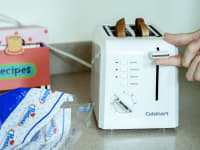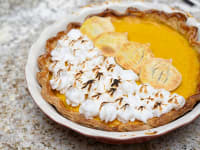This trick can revive stale bread in 5 minutes flat
There's a proven scientific method that only takes 5 minutes
Products are chosen independently by our editors. Purchases made through our links may earn us a commission.
I make dinner every single night. We rarely eat out, partly because we’re comfortable at home and partly because cooking is much more affordable than dining out, or even getting takeout.
Because of this, I know a lot of tricks to get dinner on the table quickly. But my real secret? I’m an avid meal planner. On Sunday, I sit down and map out our week. I pick up just about all of our groceries that afternoon. It’s very convenient—except when it comes to things like fresh bread. For a long time, I felt limited by the fact that we had to eat the fresh bread within 48 hours, before it got stale and hard as a rock.
But then, I read about a game-changing trick from Bon Appetit. It lengthens the lifespan of my bread, seemingly by magic.
How to soften stale bread
For crusty loaves of bread: 1. Turn your oven’s warming feature on, or preheat to 300ºF. You can use a toaster oven or a standard wall oven. 2. Stick a loaf of crusty bread under running water (hot or cold), positioning any cut sides away from the running water. (Note: This is important—I missed that part the first time I tried this, and my bread basically disintegrated in my hands.) 3. When the exterior is saturated (about 30 seconds), place the loaf on the center rack and bake for 6 to 7 minutes. 4. Slice into a loaf of bread that's crusty outside, but soft and moist inside.
For sliced or sandwich bread: 1. Wrap a slice of bread in a damp towel. 2. Place it on a microwave-safe dish. Microwave on high for 10 seconds. 3. Enjoy a fluffy, moist slice of bread.
How—and why—this method fixes hard bread
I’ll admit it, I was floored the first time I successfully executed this trick. With both the microwave and the oven, the bread really was delicious. Not perfect, but pretty darn close.
“These hacks absolutely do work,” says Ted Russin, acting dean of the School of Culinary Science and Nutrition at The Culinary Institute of America. But how? “Adding water and heat literally reverses what’s happening during retrogradation,” the technical term for when bread gets stale. The added water rehydrates the bread, and the heat sends starch granules into the disorganized state that results in fluffy, moist bread.
Here's the science behind it: When bread initially cooks from dough, the starch granules expand, says Russin. They go from a highly organized state, to one that’s more amorphous during the cooking process. When this happens, those starch granules get bigger and swell, helping to create that fluffy texture we love so much.
The challenge with that? Over time, without added heat and water, those starch granules want to reorganize themselves and return to their natural, more stable state, says Russin. That process is called retrogradation. At the same time, bread loses water and dehydrates over time. The result of these two forces at work? Stale bread.
While the water-and-heat method does work wonders, there is a catch: Make sure you only reconstitute the bread you need for each meal, and be sure to eat up quickly. “If you let that piece of bread cool down, it’s going to be more stale than it was originally,” says Russin. Each time you manipulate those starch granules, they get more tightly packed and become more stale.


